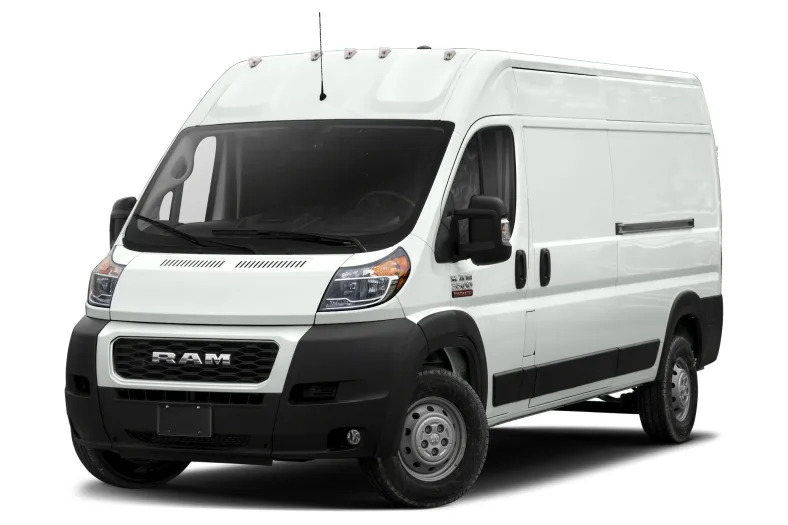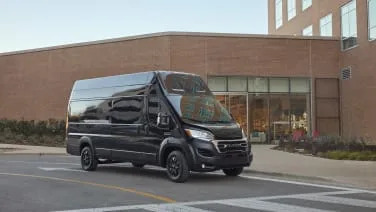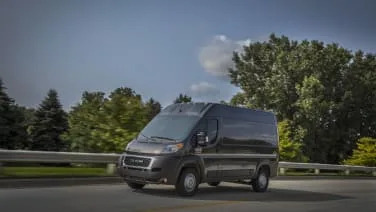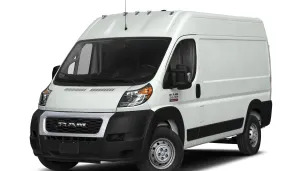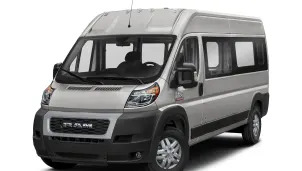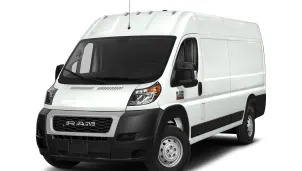High Roof 3500 Cargo Van 159 in. WB
2019 RAM ProMaster
The Maxwell RHEV looks just like any small business' panel van, sporting large vinyl graphics and unassuming steel wheels. You'd have no idea that the co-founders of the startup based out of Seattle had grafted a salvaged Voltec powertrain from a junkyard Chevy Volt into this Ram ProMaster. Somewhere, a battery pack lurks. Maxwell's co-founders, CEO Max Pfeiffer and engineer Trey Camp, open the cargo area to reveal a completely unaltered space. Both are ex-Tesla employees with a long fascination for the #vanlife movement – that their interests intersected in a hybrid cargo van isn't surprising once you start talking to them. This is their first vehicle, a salvaged ProMaster sidelined with a blown 3.6-liter Pentastar, and it's both their prototype and the only Maxwell in existence right now. That said, the company is building a low-roof version for a customer, which will be lighter, have less aero drag and therefore be more efficient. The company is just emerging from a stealth startup mode, and while their backstory is fascinating, I'm still wondering where the Volt's 18.4 kWh battery pack is. "There's nothing in the back ... we're able to get the battery underneath the floor, in the center," Pfeiffer says. Ducking my head under the side reveals, sure enough, a little underside blister that contains the battery, tucked up neatly. The other changes to the RHEV – short for Range-extended Hybrid Electric Vehicle – are minimal. He pops the hood. There are some rough edges, but the 1.5-liter, 101-horsepower engine and 48-kW motor fit comfortably on custom engine mounts and with re-routed exhaust, behind a fascia that improves aero and houses the charge port. Custom axles send power to unaltered Ram hubs and brakes. "This version, it's a little bit prototype-y," Pfeiffer says. "We've had more time to work with the CAD [computer-aided design, engineering drawings] we were able to get from GM and Chrysler, and we've done a better job packaging for production." GM already spent billions on the Voltec and its controlling software, and Maxwell can happily ride those coattails. Despite the help GM has lent Maxwell, there are no official ties. An emulator sends spoofed signals to the Ram instruments, which have a new custom-printed face. The Ram's body control module is left alone. For powertrain faults, Maxwell says the vehicle can theoretically be serviced by any Chevy dealer, and any issue with the rest of the vehicle can be handled by a Ram service shop. [The company is working on service arrangements, which aren't finalized yet. Currently servicing will be handled by independent hybrid and EV specialty service shops. - Ed.] The result of the engine transplant could be construed either negatively or positively. The 3.6-liter V6 was good for 280 horsepower and 260 pound-feet of torque, while the Voltec that took its place makes 149 hp and 294 lb-ft. The Voltec lacks the sheer grunt of the gas engine, and once the battery is depleted – something we weren't able to test in our …
Full Review
The Maxwell RHEV looks just like any small business' panel van, sporting large vinyl graphics and unassuming steel wheels. You'd have no idea that the co-founders of the startup based out of Seattle had grafted a salvaged Voltec powertrain from a junkyard Chevy Volt into this Ram ProMaster. Somewhere, a battery pack lurks. Maxwell's co-founders, CEO Max Pfeiffer and engineer Trey Camp, open the cargo area to reveal a completely unaltered space. Both are ex-Tesla employees with a long fascination for the #vanlife movement – that their interests intersected in a hybrid cargo van isn't surprising once you start talking to them. This is their first vehicle, a salvaged ProMaster sidelined with a blown 3.6-liter Pentastar, and it's both their prototype and the only Maxwell in existence right now. That said, the company is building a low-roof version for a customer, which will be lighter, have less aero drag and therefore be more efficient. The company is just emerging from a stealth startup mode, and while their backstory is fascinating, I'm still wondering where the Volt's 18.4 kWh battery pack is. "There's nothing in the back ... we're able to get the battery underneath the floor, in the center," Pfeiffer says. Ducking my head under the side reveals, sure enough, a little underside blister that contains the battery, tucked up neatly. The other changes to the RHEV – short for Range-extended Hybrid Electric Vehicle – are minimal. He pops the hood. There are some rough edges, but the 1.5-liter, 101-horsepower engine and 48-kW motor fit comfortably on custom engine mounts and with re-routed exhaust, behind a fascia that improves aero and houses the charge port. Custom axles send power to unaltered Ram hubs and brakes. "This version, it's a little bit prototype-y," Pfeiffer says. "We've had more time to work with the CAD [computer-aided design, engineering drawings] we were able to get from GM and Chrysler, and we've done a better job packaging for production." GM already spent billions on the Voltec and its controlling software, and Maxwell can happily ride those coattails. Despite the help GM has lent Maxwell, there are no official ties. An emulator sends spoofed signals to the Ram instruments, which have a new custom-printed face. The Ram's body control module is left alone. For powertrain faults, Maxwell says the vehicle can theoretically be serviced by any Chevy dealer, and any issue with the rest of the vehicle can be handled by a Ram service shop. [The company is working on service arrangements, which aren't finalized yet. Currently servicing will be handled by independent hybrid and EV specialty service shops. - Ed.] The result of the engine transplant could be construed either negatively or positively. The 3.6-liter V6 was good for 280 horsepower and 260 pound-feet of torque, while the Voltec that took its place makes 149 hp and 294 lb-ft. The Voltec lacks the sheer grunt of the gas engine, and once the battery is depleted – something we weren't able to test in our …
Hide Full Review
Hide Full Review
Retail Price
$37,645
MSRP / Window Sticker Price
| Engine | 3.6L V-6 |
| MPG | |
| Seating | 2 Passengers |
| Transmission | 6-spd auto w/OD |
| Power | 280 @ 6400 rpm |
| Drivetrain | front-wheel |
Smart Buy Program is powered by 

